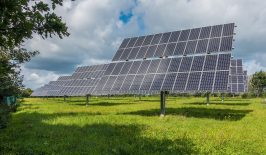Monitoring the energy consumption of your tech devices is quite simple. You can either consult the manufacturer’s information on energy consumption. Or you can run an electricity meter between the socket and the device. However, as many companies now outsource their server infrastructures, this information is typically lost. And this is exactly what “re:cinq” wants to change with the open source tool “aether”.
Providers such as Amazon with its Amazon Web Services (AWS) and Google with its own cloud aren’t transparent about energy consumption. This is where “aether” can give users more control over the energy they consume. Because “how are we supposed to reduce CO2 emissions”, says Gabi Beyer from “re:cinq” in a blog post, if we can’t measure them at all?
How do virtual servers actually work?
In order to offer their own websites and services on the internet, companies need to use servers. Whereas in the past, these had to be operated in rooms that were too hot to handle in-house, companies can now rent servers and outsource their infrastructure. To make this article visible online, for example, we use the green cloud provider Hetzner for our RESET.org website. We rent a fixed amount of storage space from Hetzner to operate our content management system.
Providers such as Amazon and Google offer virtual servers that can grow depending on traffic and the amount of storage space required. “Scalable hosting services” offer many advantages for users. For example, if there is suddenly a lot of traffic, virtual servers can automatically increase in size and absorb the extra demand accordingly. However, this also means that users run the risk of their own online presence consuming a lot of energy and water for cooling.
Server usage may seem almost immaterial to companies and end users. However, hosting companies process data in physical data centres and server farms. While companies can monitor and optimise the energy consumption of their IT infrastructure in their own operations, providers such as AWS and Google do not provide such information directly. For this reason, “aether” is a helpful aid for companies that want to act sustainably in terms of corporate digital responsibility.
“aether” retrofits a virtual electricity meter
The source code for “aether” is available to interested parties free of charge via the Github platform. The application doesn’t require any additional accessories or special components on the server side. Chip manufacturer Intel, for example, installs components in its chipsets that can measure the energy consumption of the entire circuit board. Running-Average-Power-Limit-Reporting, or RAPL for short, is not required when using “aether”.
The developers of “aether” chose a calculation-based approach, which means users don’t require specialist hardware. In this approach, the vCPU hours are calculated first—i.e. the total number of usage hours, which is offset against the number of virtual processor units. The developers calculate their energy consumption using the CPU utilization and the information on power consumption, which is stored in Teads data sets. This information is provided by virtual server providers.
From this information, “aether” can then use other factors to calculate the approximate CO2 emissions of CPU units of virtual servers. In addition to this approximate value, the developers would also have to take the power consumption of additional components into account. The “re:cinq” team would therefore like to integrate the energy consumption of GPUs and memory components in future versions.
In her blog entry, however, Gabi Beyer expressly points out information isn’t fully accurate. This is due to is a lack of transparency from the cloud providers themselves.
How can you reduce the power consumption of virtual servers?
Knowing approximately how much energy a rented server consumes is helpful—but it does not solve the problem of energy-hungry server farms. Personal servers can be upgraded with more energy-efficient components or reduced to the required performance. With virtual servers, however, customers generally have no influence on the hardware.
We asked the “re:cinq” team how we can reduce the power consumption of virtual servers. On the user side, “re:cinq” suggests placing value on sustainable programming. Using “Big O Notation”, they could estimate the energy efficiency of written lines of code during development.
Why do data centers consume water?
Data centres are essentially large halls containing countless computers. Operating data centres has a high power consumption and generates a lot of heat.
To prevent the devices from overheating, data centres require extensive cooling. And this is usually done using water-based cooling systems.
Data centres are criticised for their water and energy requirements. They are often located in less densely populated regions, where the water supply is frequently inadequate. In this interview, Friederike Röhde from the IÖW reveals more about the problems that data centres can cause.
In addition to optimising code, servers can also be optimised for energy efficiency without changing the hardware. In a blog entry, the “aether” team shows how it’s possible to adapt the node sizes to the required application. This reduces power consumption, as the hardware only uses the necessary components required for smooth playback.
There is also the phenomenon with servers that hardware utilisation and energy consumption aren’t linear. If a server is about 10 percent utilised by an application, it consumes 10 watts per hour. If an additional task adds 10 percent, the energy consumption increases by less than 10 watts. So running servers at maximum capacity leads to lower power consumption in the long term than running multiple servers. Data centres should therefore optimise their systems for “energy proportionality”.
Sustainable hosting providers are a green alternative
The development of “aether” shows how difficult it is to optimize the efficiency of outsourced IT infrastructures. This is because the optimisation of node sizes and “energy proportionality” must take place on the server side. To enable companies to use their services sustainably, companies such as Google and AWS must become more transparent.
However, there are also many green cloud and hosting providers such as Windcloud or Manitu. These alternative providers rely on 100 percent green electricity and optimise their server infrastructure in terms of energy efficiency. We have summarised further ways to reduce your own digital footprint in the article “How to reduce your digital footprint”.








